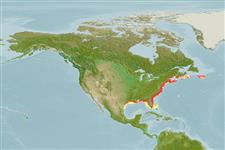Environment: milieu / climate zone / depth range / distribution range
Écologie
marin récifal; océanodrome (Ref. 51243); profondeur 1 - ? m (Ref. 9988). Temperate; 45°N - 25°N
Western Atlantic: Canada (Ref. 5951) to Maine to northeastern Florida in USA and eastern Gulf of Mexico; reaches extreme southern Florida during cold winters.
Length at first maturity / Taille / Poids / Âge
Maturity: Lm 19.1, range 11 - ? cm
Max length : 66.0 cm TL mâle / non sexé; (Ref. 40637); common length : 30.0 cm TL mâle / non sexé; (Ref. 3708); poids max. publié: 4.3 kg (Ref. 4699); âge max. reporté: 20 années (Ref. 34089)
Commonly found around rock jetties and on rocky bottoms in shallow water. Marketed fresh and eaten fried, broiled and baked (Ref. 9988).
Also Ref. 32209, 103751.
Robins, C.R. and G.C. Ray, 1986. A field guide to Atlantic coast fishes of North America. Houghton Mifflin Company, Boston, U.S.A. 354 p. (Ref. 7251)
Statut dans la liste rouge de l'IUCN (Ref. 130435)
Utilisations par l'homme
Pêcheries: commercial; pêche sportive: oui; Aquarium: Aquariums publics
Outils
Articles particuliers
Télécharger en XML
Sources Internet
Estimates based on models
Preferred temperature (Ref.
123201): 10.8 - 24.9, mean 23.6 °C (based on 244 cells).
Phylogenetic diversity index (Ref.
82804): PD
50 = 0.5312 [Uniqueness, from 0.5 = low to 2.0 = high].
Bayesian length-weight: a=0.01148 (0.00969 - 0.01361), b=3.04 (2.99 - 3.09), in cm total length, based on LWR estimates for this species (Ref.
93245).
Niveau trophique (Ref.
69278): 3.9 ±0.2 se; based on diet studies.
Résilience (Ref.
120179): Milieu, temps minimum de doublement de population : 1,4 à 4,4 années (K=0.23-0.46; tmax=20).
Prior r = 0.31, 95% CL = 0.20 - 0.46, Based on 1 stock assessment.
Fishing Vulnerability (Ref.
59153): Moderate vulnerability (40 of 100).
Climate Vulnerability (Ref.
125649): Moderate to high vulnerability (46 of 100).
Nutrients (Ref.
124155): Calcium = 10.3 [5.8, 21.8] mg/100g; Iron = 0.206 [0.105, 0.391] mg/100g; Protein = 18.8 [16.9, 20.6] %; Omega3 = 0.401 [0.220, 0.718] g/100g; Selenium = 9.98 [4.95, 22.14] μg/100g; VitaminA = 60 [17, 246] μg/100g; Zinc = 0.411 [0.270, 0.632] mg/100g (wet weight);
